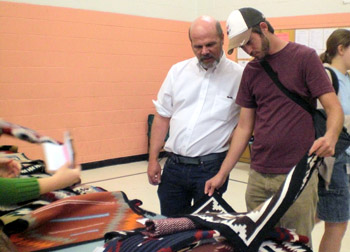Architecture Professor Mark Childs decided that the research studio he was teaching this fall would have a strong emphasis on investigation that is applicable to design. He said, “I’ve done lots of projects I had to do. This time I did one I wanted to do.” The project he selected for the class was to research the Crownpoint Navajo Rug Auction. Crownpoint is in McKinley County, northeast of Gallup. The students were charged to design a mixed-use facility to accommodate the auction, but since that’s only a one a month event, the facility could serve other purposes, as well.
The auction currently takes place in the “cafegymatorium,” at Crownpoint Elementary School. The weavers pile their rugs on tables and people lift them to find the rug they want to buy.
Before taking a step into developing the course, however, Childs got permission from the rug weavers.
Childs, a prolific researcher, spent the summer poring over books about the area, the rug weaving tradition, the weavers and just about anything he could put his hands on. Those titles became part of a bibliography included in the class syllabus.
The first five weeks of the course were dedicated to research. “The students went to the executive director’s house and to an auction,” Childs said. They got to talk to the people who run the auction and to rug experts. At the close of that period, the students presented 10 minute videos on an aspect of their research, whether it was the history of rug making, about the designs of the rugs or an assessment of the region.
“Architects will be using video and other electronic imaging more in their presentation to clients. Also, the students learned the value of time with a 10 minute limitation,” he said. Childs loaded the presentations onto a YouTube site that reviewers could then access to brief themselves before coming to a review. “That’s something they can’t do with classic board presentations,” he said.
The research the students completed resulted in strong designs. One student designed elegant trusses with the materials having a Navajo origin. “They were designed to be reminiscent of looms and weaving.” A reviewer said one of the projects was “ready to go into final design,” Childs said. “It was not because it was simple, but it was incredibly well worked out,” he said. Reviewers who practice on the Navajo reservation were brought in.

Architecture Professor Mark Childs, left, and graduate student
Brad Pulliam examine rugs at the Crownpoint Rug Auction.
In thinking about other programmatic uses for the facility, students suggested a business incubator, Boys & Girls Club, arts center and a hotel or lodge – Childs likes that idea because there are no hotels in the area and one could also serve visitors to Chaco Canyon.
Childs wanted to make sure the designs were not cliché.” We struggled with that issue. We aimed for designs that understood and respected Navajo design traditions in more than a superficial way. We looked at local materials and construction skills; local climate; the relationship to the incredible landscape; myths and traditions; and the art of the Navajo rug” he said. He added that they were designing a facility that is a meeting place to bring in buyers. “It has a different responsibility to traditions than a Chapter House or other government building,” he said.
The students’ designs didn’t end at the edge of the building. “My critique of architecture students is that they often don’t design beyond the air conditioning. They had to design outside, including a parking lot. They needed to pay attention to portals and porches and the in between spaces,” he said.
They had to design a dye garden. “The intent is to enhance the experience of going to the rug auction. They are handmade and dyed using plants in the landscape,” Childs said. Two landscape architecture students did an independent study with Childs and conducted research on the common dye plants and figured out which ones can grow in the Crownpoint region. “They actually made a deck of cards with the plants. They are in discussion about publishing them,” he said. He added that the landscape students also gave the architecture students generic patterns for the gardens.
“All the students learned about New Mexico and this important cultural institution. They enjoyed the cross-cultural experience. They learned what it means to design in another cultural base. Those skills will serve them whether they design in Shanghai or Syracuse,” he said.
![Students unite form, function in design for Crownpoint [article image]](crownpoint/navajo-rug-auction-banner.jpg)
